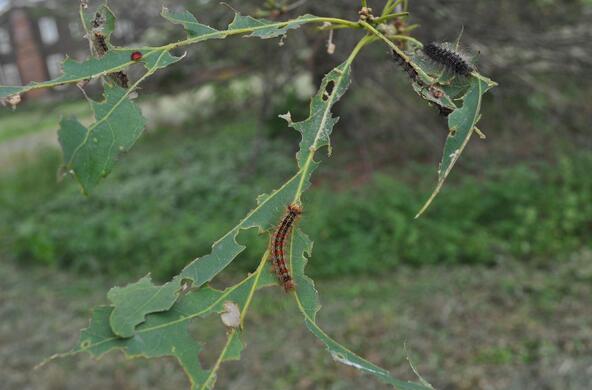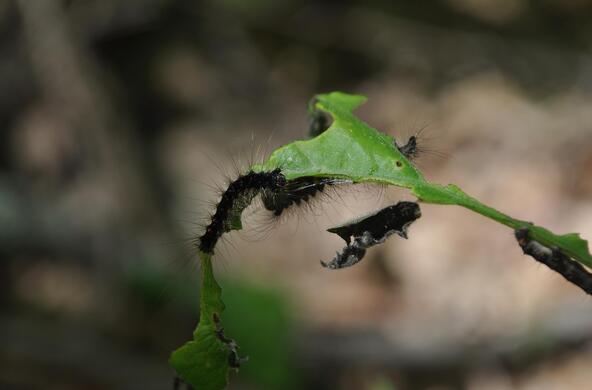USDA was required by the 2018 Farm Bill (section 10110) to produce a report on their efforts to prevent forest pests from entering the country in international trade. The report, which was released in March 2021 by the Animal and Plant Health Inspection Service (APHIS), is unfortunately brief and superficial. However, it does amplify some key aspects of the problem, and it highlights the need for Congressional action to protect the nation’s forests and to maintain the carbon sequestration that they provide.
The importation of forest pests through international trade continues, despite efforts to stop it.
The report indicates that approximately 3,000 forest pests were intercepted by APHIS and CBP inspectors between 2013 and 2018. Because only 1-2% of cargo and plants are inspected at ports of entry, the actual number of pests brought into the country on the uninspected cargo is much higher than 3,000. The report did not attempt to estimate the actual number of imported pests.
The most important pathways by which these pests enter the country are solid wood packaging material and live plants imported for the nursery industry.
The report states that 93% of the pests that were intercepted were in wood packaging such as crates, pallets and dunnage.
Current policies to reduce the importation of these pests are helpful, but not sufficient.
The report cites a scientific paper by Haack et al (2014), which calculates that the regulation requiring treatment of wood packaging has been 36-52% effective in reducing pest importation via that pathway. The inefficiency of this policy allows over 13,000 shipments of infested wood packaging to enter the country every year, with each one being an opportunity for an invasive insect to become established in the country. The report notes a number of other actions that APHIS is taking, but makes no attempt to evaluate their effectiveness.
New outbreaks of forest pests continue to plague our forests and cities.
The report lists several new detections of forest pests, and discusses the large outbreak of the very dangerous Asian Longhorned Beetle discovered in South Carolina in 2020. The report states that “There have been no outbreaks of new forest pests in the United States since 2014.” This statement is incorrect as it ignores the outbreaks of Asian longhorned beetle in South Carolina in 2020 and Mediterranean oak borer in California in 2018. Additionally, the choice of 2014 as a starting point is arbitrary; between 2012 and 2014 there were outbreaks of several new pests and diseases: Beech Leaf Disease in Ohio, Spotted lanternfly in Pennsylvania, and “Rapid Ohi’a Death” in Hawaii. The point is that we continue to import these pests through international trade and we continue to see new outbreaks across the country.
More can and should be done to stop these pests from entering the country.
We agree with the report’s acknowledgement that surveillance and detection for new pest outbreaks could be improved if more funding were available. In addition to the current USDA monitoring networks, there are many opportunities to enhance our ability to detect new pest outbreaks using remote sensing and employing citizen science. The report does not discuss any other ways that programs can be improved to combat this problem. We suggest two that could be started immediately, at low cost:
- APHIS should more aggressively enforce existing regulations by prosecuting egregious violations and repeat offenders.
- APHIS should release information about each incident in which importers or shippers have been found to violate the wood packaging regulations, including where the infested wood packaging material was acquired and supposedly treated against insects. This would assist the private sector in keeping pests out of their international supply chains by allowing them to make better choices about where they purchase wood packaging.

In addition, there are other ways to improve pest prevention programs that would require interagency cooperation and/or increased funding. These include:
- APHIS and CBP should increase inspections of incoming cargo and live plants.
- APHIS and the Forest Service should make “sentinel plantings” of US tree species in botanical gardens abroad to discover which pests pose the greatest threat to these trees. Inspection programs can then be on the lookout for these pests.
- APHIS should explore new technologies for more efficient detection of pests and diseases in cargo and on live plants, including molecular, chemical and acoustic sensing.
- APHIS should use its authority to curtail imports of live plants that pose a high risk of transmitting pests and diseases to tree species that are important in natural and urban forests in the U.S.
Congress has a real opportunity to bolster carbon sequestration and forest health by evaluating APHIS’s performance in preventing invasive forest pests from entering the country, and enacting legislation as needed to help the agency improve its record.
We urge the House and Senate Agriculture Committees to hold hearings to fully investigate this issue, and explore these and other solutions to help protect the trees in our forests, parks and neighborhoods.








